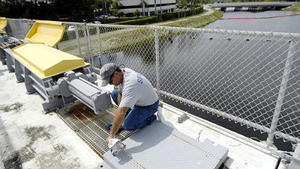The water we drinkFlorida City to inject treated sewage directly into underground aquifer
Florida’s Biscayne Aquifer has begun to run low and communities are exploring alternative sources of water as well as methods to stretch existing sources; the city of Pembroke Pines plans to inject treated sewage water 60 to 200 feet below ground directly into underground aquifers rather than use the existing practice of pumping treated water into nearby wetlands, lakes, or fields, where it will slowly trickle down into the aquifer over several months or years

Treated sewage to be injected directly into water supply // Source: sun-sentinel.com
Pembroke Pines, located in south Florida, is currently exploring a $47 million plan to slow the depletion of its water supply by directly injecting about seven million gallons a day of treated sewage into the Biscayne Aquifer.
The Biscayne Aquifer, a 4,000 square mile series of underground limestone caves that provide fresh water to Broward County, Miami-Dade County, Monroe County, and Palm Beach County, has begun to run low and communities are exploring alternative sources of water as well as methods to stretch existing sources.
Using treated sewage to augment water supplies is not a new practice, but Pembroke Pines is taking a novel approach. The city plans to inject treated sewage water 60 to 200 feet below ground directly into underground aquifers rather than use the existing practice of pumping treated water into nearby wetlands, lakes, or fields, where it will slowly trickle down into the aquifer over several months or years. Much of the state, including six cities near Pembroke Pines, already employs this existing method to slow the depletion of their local water sources.
There are several drawbacks to the project as the Sun Sentinel reports. According to Harold Wanless, professor and chair of geological sciences at the University of Miami, there is no way to determine exactly where the pumped sewage water will go because aquifers have their own currents.
“It’s difficult to tell where any particular water will move to. We don’t have the large conduits inside the aquifer well mapped,” Wanless said.
Furthermore, there are possible geological consequences to the plan. Wanless pointed out that forcefully injecting water into the underground aquifer could change limestone formations, which could potentially lead to the mingling of the fresh water from the Biscayne aquifer with the brackish water of the nearby Floridan Aquifer.
Environmentalists are also concerned about the effects of pumping treated water into the aquifer, which is home to a diverse set of plants and animals. The water will be treated in a two stage purification process, but where waste is first broken down with bacteria before being sanitized with chlorine and then made drinkable through reverse osmosis, concerns remain.
Matthew Schwartz, political and Everglades chair of the Broward-area Sierra Club, states that “there’re limitations to how clean that water can be made. You can’t remove all pharmaceuticals from the water. It can’t be done. You are putting drugs into our drinking water … Tylenol, birth control medication, antipsychotics.”
Despite these concerns, Pembroke Pines officials are hoping to press ahead with the proposed plan due to their limited options. Other proposals, like building a plant to purify water taken from a deeper aquifer or installing another series of pipes to use partially cleaned sewage for lawns and fountains, will be too costly. Instead, the city has focused on sewage treatment technology passing a $12.3 million bond measure to fund experiments in sewage research and treatment in addition to the $2.7 million they have already spent on research.
Their goal, according to Shawn Denton, director of public works in Pembroke Pines, is to find the most efficient, eco-friendly, and “cutting edge” techniques to recycle sewage into tap water.
Currently, only about seventy-one million gallons out of a total of roughly 640 million gallons of sewage produced in the area each day gets reused, so there is significant untapped potential to dramatically reduce consumption through reuse.
If Pembroke Pines can successfully replenish its aquifers using this technique, other communities seeking to reuse their water more efficiently can look to this as another method to effectively slow the depletion of their local water sources.
